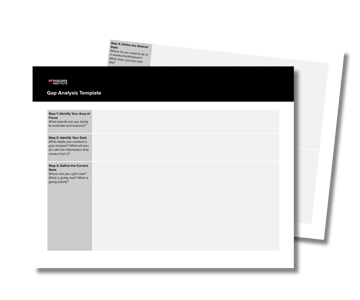6 min read
The Start-Stop-Continue Exercise: How To Conduct One (+Template)
In our search for improvement, we often find ourselves reflecting on what works, what doesn't, and what needs to change. This process of evaluation...
4 min read
 Michelle Bennett
:
Oct 19, 2023 5:00:00 AM
Michelle Bennett
:
Oct 19, 2023 5:00:00 AM

In today’s workplace, staying static is not an option. If you fail to continuously improve everything from your performance to your team’s culture, you run the risk of falling behind, sometimes irreversibly so.
For this reason, it is essential to have a gap analysis in your toolkit. A gap analysis is an invaluable tool that prompts you to assess, identify, and address the discrepancy between the current state of either yourself, your team, or your organization, and the state which you desire to get to in the future.
In this article, we’ll provide you with a simple definition of a gap analysis, review the three (arguably four) fundamental components, five common use cases in the workplace, and finally, how to use a gap analysis template to get started. Let’s begin.
By definition, a gap analysis is used to identify the discrepancies between the current state and the desired state of something in the workplace. Most often, it is used to pinpoint specific areas where an individual, team, department, or organization is falling short in terms of performance, skills, resources, culture, or strategy. The purpose of a gap analysis is to identify opportunities for improvement and growth and then develop an action plan to effectively and efficiently close those gaps.
If you Google ‘gap analysis,’ you will quickly discover that there are quite literally hundreds of different variations that exist. If you look closely, though, you will notice that three fundamental components always appear in a gap analysis. Those components are:
However, the problem with a gap analysis that only includes these three components is that it falls short of being actionable. If you truly want to bridge the gap between the current and future state, you need to include a fourth fundamental component - an action plan. Once you know where you are, where you want to go, and what’s keeping you from getting there, look at what tactically needs to be done to make that a reality and then assign deadlines, responsibilities, and resources accordingly.
Regardless of whether you’re a first-time supervisor, a middle manager, or a senior executive, it’s important that you know how to run a gap analysis. It’s one of those tools in the workplace that you will come back to time and time again. In fact, here are five common types of gap analysis’ that you will likely conduct at some point or another in your leadership career.
A skills gap analysis is a means of assessing the disparity between the skills and competencies a person currently has and the skills and competencies they need to succeed in the future. A skills gap analysis can be completed by an individual for themselves or by a leader for their employees. In either case, the purpose of this type of gap analysis is to recognize a person’s strengths, identify their weaknesses or areas for growth, and subsequently create a personalized development plan to ensure the person acquires the skills and competencies they need to meet the current and future needs of their role.
A performance gap analysis is used in the workplace to compare the actual performance of an individual, team, or organization against the desired or expected level of performance. This type of gap analysis takes a number of different factors into account, including goals, targets, key performance indicators, metrics, and objectives. The purpose of doing so is to be able to clearly see where performance is lacking and put a performance improvement plan into place to bridge any gaps that threaten an individual, team, or organization’s success.
A strategic gap analysis is a tool used to evaluate the current strategic position of a team or organization in comparison to its desired future state. The point of this type of gap analysis is to help leaders pinpoint areas where their team or organization is failing to achieve its strategic objectives or where it is not aligned with trends in the market, customer needs, or competitive forces. With that information, leaders can make necessary adjustments to their strategy, goals, and objectives.
If you’re committed to improving the culture of your team, department, or organization, a culture gap analysis is a necessary step in the process. That’s because a culture gap analysis will prompt you to examine how your existing culture differs from your ideal or desired culture. By looking closely at your values, norms, behaviors, and processes, you can identify what needs to be preserved, what needs to change, and what needs to start happening in order to create a work environment that supports the achievement of your goals and contributes to a positive employee experience.
Simply put, a resource gap analysis is used to assess what resources an individual, team, or organization actually currently has available and what resources it needs to complete a project, accomplish a goal, or meet demands. Resources can refer to everything from finances to people, technology, time, and materials. When a resource gap analysis is thoughtfully and thoroughly conducted, it allows you to properly allocate (or reallocate) resources, make more informed decisions, and petition for more resources as needed.
 Now that you have a better understanding of what a gap analysis is, what it should include, and the common use cases, you might be ready to conduct your own. In which case, use this Gap Analysis Template to easily get started. Upon downloading the template, you will receive not only a fully editable Google Doc but also a PDF so that you can print it off if that’s what you would prefer. Moreover, here are step-by-step instructions for you to follow along with as you begin using the Gap Analysis Template.
Now that you have a better understanding of what a gap analysis is, what it should include, and the common use cases, you might be ready to conduct your own. In which case, use this Gap Analysis Template to easily get started. Upon downloading the template, you will receive not only a fully editable Google Doc but also a PDF so that you can print it off if that’s what you would prefer. Moreover, here are step-by-step instructions for you to follow along with as you begin using the Gap Analysis Template.

6 min read
In our search for improvement, we often find ourselves reflecting on what works, what doesn't, and what needs to change. This process of evaluation...

7 min read
When was the last time you or your team stepped back and learned from an experience or situation at work? For many who are fighting to meet tight...

7 min read
Whether you’ve heard of the Six Thinking Hats before, consider this as your sign to give it a try for yourself at least once. Here’s why. Not only is...